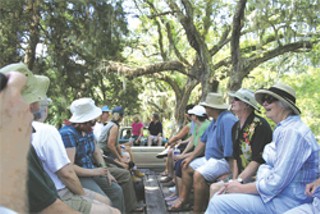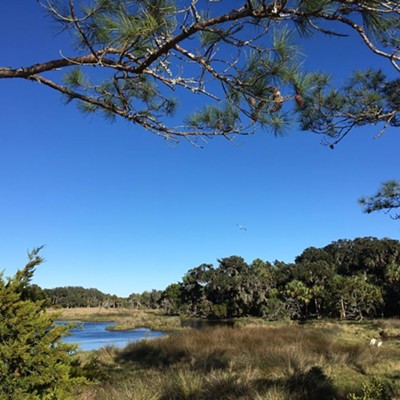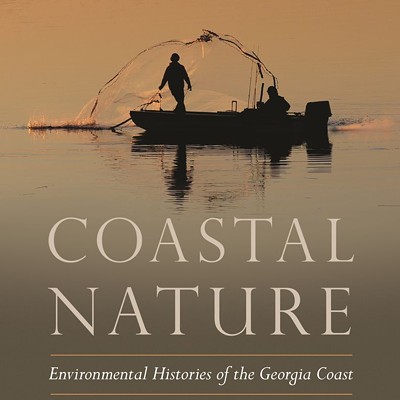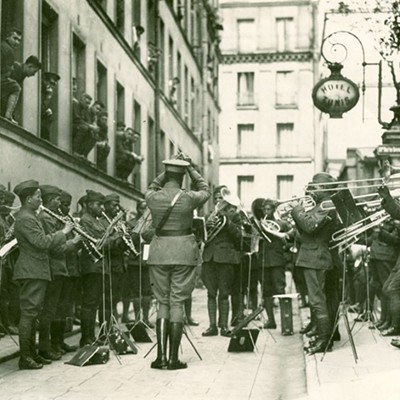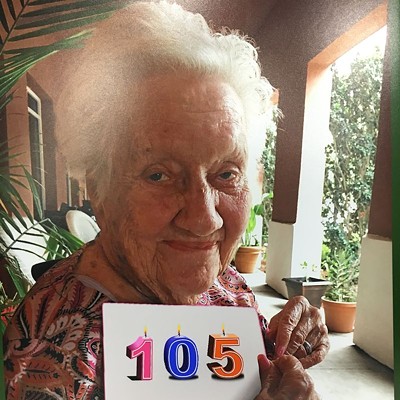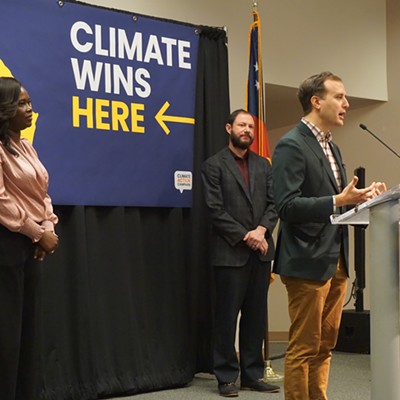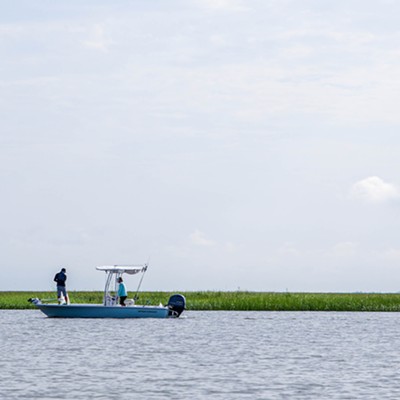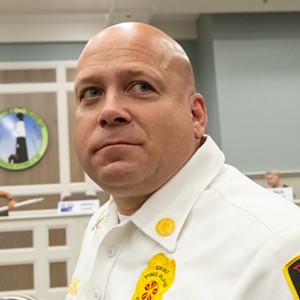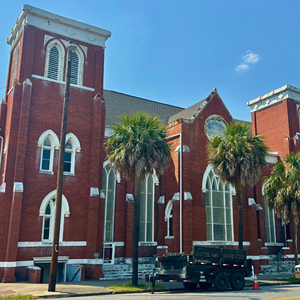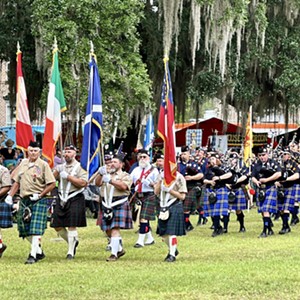First, the bad news: There’s cellphone coverage on Ossabaw Island.
Jarring as that fact is in this otherwise almost completely undeveloped place accessible only by boat, it’s an important reminder that this large barrier island—twice the size of Bermuda and the third largest on the Georgia coast, after Cumberland and St. Simons—is a mere 15 minutes from the south end of Skidaway Island.
I make the trip as part of a twice-a-year public tour sponsored by the Ossabaw Island Foundation, which manages the cultural and educational aspects of the island (the state itself has owned it since 1978).
After a breezy, gorgeous ride from Delegal Marina courtesy of Capt. Michael Neal of Bull River Cruises, we pull up to Ossabaw’s modest dock, where we’re greeted by Jim Bitler, on-island coordinator.
I expect a hard-bitten outdoorsy type with a thick drawl, but instead we get a gregarious and urbane host who wouldn’t be out of place at a cocktail party north of Gaston. “Welcome to the real world,” Bitler laughs as we disembark. Since joining the Foundation five years ago, he’s lived in a trailer on the island, though he’s set to move into the historic, restored “boarding house” by the end of the year.
Within minutes, we hear the steady boom of rifle fire in the distance.
“Feral hogs,” explains Bitler. “They’re extremely destructive. There are two full-time DNR people here whose only job is to kill as many as they can.”
The pigs are a direct legacy of the Spanish missionary presence on the Georgia coast in the 1500s. “The Spanish used the island like a refrigerator,” Bitler says.
They left a couple of pigs behind, let nature take its course, and came back later to find a plentiful new source of barbecue. Unfortunately this invasive and prolific species uproots native vegetation and has developed a taste for the eggs of endangered loggerhead turtles — hence the rifles.
As barrier islands go, Ossabaw is unusual in that it’s made of two distinct parts: One Pleistocene, i.e., formed during the last Ice Age, and the other Holocene, formed after the Ice Age.
“What’s so cool about Ossabaw is that geologically you have two completely different areas,” Bitler says. “It’s a wonderful habitat mosaic, with incredible diversity.” Presumably he’s not just referring to pigs.
The human history of Ossabaw goes back to 4,000 years ago, the estimated age of a piece of Native American pottery found on the island’s north end. Several burial mounds are in the center, where Buckhead Creek cuts into the midsection. Not only a safe and convenient harbor for their canoes, the central marsh was also a key food source, as evidenced by the large refuse piles, or middens, made of oyster shells.
“This was their Piggly Wiggly,” says Bitler.
Ossabaw is part of the earliest snapshot of settlement in Georgia, and is mentioned in the famous “Treaty of Friendship” between James Oglethorpe and the Creeks.
“It gave to the crown all the land ‘as far as the tide ebbs and flows,’ from the Savannah River to the Altamaha River, with the exception of Sapelo Island, St. Catherine’s Island, and Ossabaw,” says Bitler. “So what’s interesting is that from the very first chapter of Georgia history, Ossabaw is named and we can follow what’s happened to it. Whether it’s Indians or colonists or the antebellum period or afterward, all those stories are here on the island and are being documented by the Foundation.”
Indeed, Ossabaw’s beguiling ability to maintain both timelessness and relevance— exemplified by being able to use your cellphone amidst 100-year-old oaks and pigs left by conquistadors — is part of what makes it so magical.
In 1760 the north end became an indigo plantation under John Morrel. At one point we actually see a lone, wild indigo bush, a direct descendant of the indigo grown on Ossabaw to make blue dye for clothing around the world, including the famed serge de Nimes—the fabric known today as denim.
Morrel is responsible not only for the famous “Avenue of Oaks” on Ossabaw, but the historic dirt road it overhangs, running nearly the whole north-south spine of the island. Later on, as we bump along in a flatbed towed by Bitler’s pickup, he tells us we’re traveling what’s possibly the oldest continuously-used road in the United States.
“Look back down the road,” he says during a brief stop. “You’re looking into the colonial period, the time of Benjamin Franklin and the founding fathers.”
After the Revolution, with indigo no longer subsidized by Great Britain, Ossabaw planters switched to cotton. It was then that the slave economy gathered full momentum, as evidenced by the three surviving tabby slave quarters. The Foundation is spending well over a million dollars not only to restore the slave quarters, but to assemble a complete archaeological portfolio on them as well.
“We’re taking this project very slowly,” Bitler says. “We want to give these buildings a chance to tell us their stories.”
So far the big surprise has been the amount of weaponry-related artifacts found at the slave quarters. “Irish gun flints, English gun flints, French gun flints, musketballs, powder,” lists Bitler. “Turns out that was perfectly appropriate to life on these barrier islands, where owners let their slaves have firearms to supplement their food.”
A large amount of child-related artifacts have been found around the slave quarters as well. “We found pottery from a child’s tea set. We found part of a doll, and marbles from Germany.”
Archaeologists have also found infant beads painted “haint blue,” a color intended to ward off evil spirits.
After the Civil War and the collapse of the slave economy literally overnight, Ossabaw entered the brief Freedmens Bureau period. Under Sherman’s famous Field Order 15, freed slaves were to be given the proverbial 40 acres and a mule on Georgia’s sea islands. By 1867, Bitler says, “that concept was scrapped and the Morrels were able to pay the back taxes and reclaim their land.”
Thus began what Bitler refers to as “the second northern invasion,” when a series of wealthy northerners came down to Georgia and began buying up cheap land for winter getaways.
“A lot of people today credit the state with how wonderful the coastline is,” Bitler explains. “I have a lot of respect for the state of Georgia, but it had nothing to do with the state. It was the families that owned these islands and made really difficult decisions to preserve them.”
By 1924 Ossabaw had passed through several owners before ending up in the hands of Dr. and Mrs. Henry Torrey of Grosse Point, Michigan. Though successful in his own right, Dr. Torrey married quite well.
“He married the daughter of one of his patients, one Nell Ford from Michigan,” says Bitler. “Though they were always quick to point out that they were not the automobile Fords—those were the ‘upstart Fords.’”
Rather, Ossabaw’s Fords were the “chemical Fords,” an ancestor of whom in 1880 made the first successful pour of plate glass in America and founded the Pittsburgh Plate Glass Company.
The Torrey’s original home in Savannah, used only to escape the Michigan winter, was in what’s now Greenwich Cemetery adjacent to its more famous neighbor Bonaventure. In the Victorian era the site was occupied by the grand Greenwich Plantation, which burned to the ground in 1923.
The Torreys then made a lowball offer of $150,000 to the Savannah firm Strachan Shipping, which then owned Ossabaw.
Amazingly, the offer was accepted, and work began on a 15-bedroom Italianate villa, which still stands today and is the year-round residence of Dr. Torrey’s granddaughter, Eleanor Torrey West, known to friends and family simply as “Sandy.”
Now 95 years old, the famously feisty Sandy West is directly responsible for Ossabaw surviving the wave of development that has consumed other sea islands such as Tybee, Hilton Head, and St. Simons. In 1960, she took her island in a completely different direction. Instead of a sportsman’s retreat, she began the Ossabaw Island Project, opening her house up to such leading figures as Margaret Atwood, Aaron Copeland, and Samuel Barber.
By 1970, Mrs. West decided that young people in America were becoming “increasingly disconnected to the natural world,” Bitler explains. “So she began the Genesis Project specifically to address the idea that young people need to be able to deal with things like wind and tides and weather.”
During our tour we see remnants of this era. A Gothic-looking building in the center of the island was constructed by Genesis Project volunteers in 1980 out of trees downed by Hurricane David. Nearby, what was once a solar sauna and shower is now a cozy home to a family of vultures.
As a result of hosting so many visitors, however, Mrs. West did what no one thought possible: She began running out of money. Compounding her financial difficulties was the fact that property taxes had increased 500 percent since she took over ownership of Ossabaw.
“So she went to the feds, who said they could keep it from being developed by turning it into a national park,” Bitler says. “She went to the state, who said they could keep it from being developed by making it a state park.”
Neither alternative pleased Mrs. West, who reportedly said, “I will not have cardboard-hat people standing on the side of the road telling people where to take pictures!”
Bitler thanks Mrs. West for teaching him what preservation really means.
“I now understand that when she said, ‘I want to preserve the island,’ and they said, ‘We’ll keep it from being developed,’ that’s two different things,” he says. “There’s a character to this place, and just not putting buildings on it doesn’t preserve it.”
After exhaustive negotiations, Mrs. West sold Ossabaw to the state of Georgia for $8 million in 1978—half its market value—but only if the state would agree that it only be used for natural, cultural, and scientific research and education.
“And she added a lot of caveats,” Bitler says. “She told them, ‘Oh, by the way--no roads are ever to be paved. No bridge is ever to be built. No regularly-scheduled ferry service is ever to be established. No airstrip is ever to be incorporated.”
And thus Ossabaw became Georgia’s first Heritage Preserve. Today, the state handles the infrastructure and environmental management, while the Ossabaw Island Foundation handles the cultural and educational aspects, “the people stuff,” as Bitler puts it.
While it’s commonly thought that you have to be invited to go to Ossabaw, this isn’t true. “You just have to have permission,” Bitler says.
Mike Neal has been taking passengers to Ossabaw for at least ten years, and he says the changes he’s seen in the last several years have been “remarkable.”
“Eight years ago it was like you could only come if you were rich, or a DNR-type person,” Neal says. “But that’s totally changed. You can come to Ossabaw if you have a reason to come— you’re an artist, your group wants to learn history, or you want to bring a garden club here.”
Neal says while logistics limit the number of groups the island can host, “it’s very open now. It’s changed 100 percent.”
We’re a very lucky group today, as we get to tour the grounds around Sandy West’s house. Indeed, Mrs. West is inside the house as we visit.
The large entrance gate stands isolated and overgrown with vines, in ruin-like grandeur. Inside stands the 20,000 square-foot West villa itself, once the home of the Ossabaw Island Project and now Mrs. West’s full-time residence.
Unlike other structures on the island, some of which are meticulously restored, the reddish-brown, terra cotta-roof villa has the distinctly shabby-chic feel of the surrounding grounds. The whole unkempt vibe is deliberate, part of Mrs. West’s vision for Ossabaw itself.
“Historically the gates would have been kept shut, and a ten foot fence once ran from the end of the wall out to the water’s edge,” explains Bitler. “But Sandy always said that animals are more interesting than azaleas. So she said, ‘let the fence come down,’ and when it did, the animals came in.”
Mrs. West insists her home will never become a house museum. “Sandy says, ‘I will not have people pay $15 to peruse my particulars,’” Bitler relates.
When the lady of the house finally “relinquishes life estate,” as Bitler euphemistically puts it, the home will become property of the state and the Foundation will begin raising funds to restore it with the goal of once again opening it up to visiting artists and creative people.
As we leave we take an instinctive last look into the living room to see if we can sneak a peek of Mrs. West. It’s easy to see inside because of the room’s massive plate glass window — at one time the largest piece of plate glass in the country and a legacy of the fortune that built this house in the first place. But, not a glimpse of Mrs. West is to be had.
On the drive back to the dock, we finally see a cluster of those feral hogs, a dozen or so in a tight group, madly rooting away at something on the edge of the marsh. I had expected grotesque, slobbering beasts, ferocious wild boars of the type found throughout south Georgia.
But no. Ossabaw’s hogs are smallish, colored in an attractive black and white pattern, and actually kind of cute.
Still, I’ve been on Ossabaw long enough this day to feel protective of the island’s fragile ecosystem, and almost wish there was a rifle handy. Is that bad of me? I mean, we all love a little barbecue, right?
The next public education tour of Ossabaw Island is planned for September. For info, call 233-5104 or go to www.ossabawisland.org
